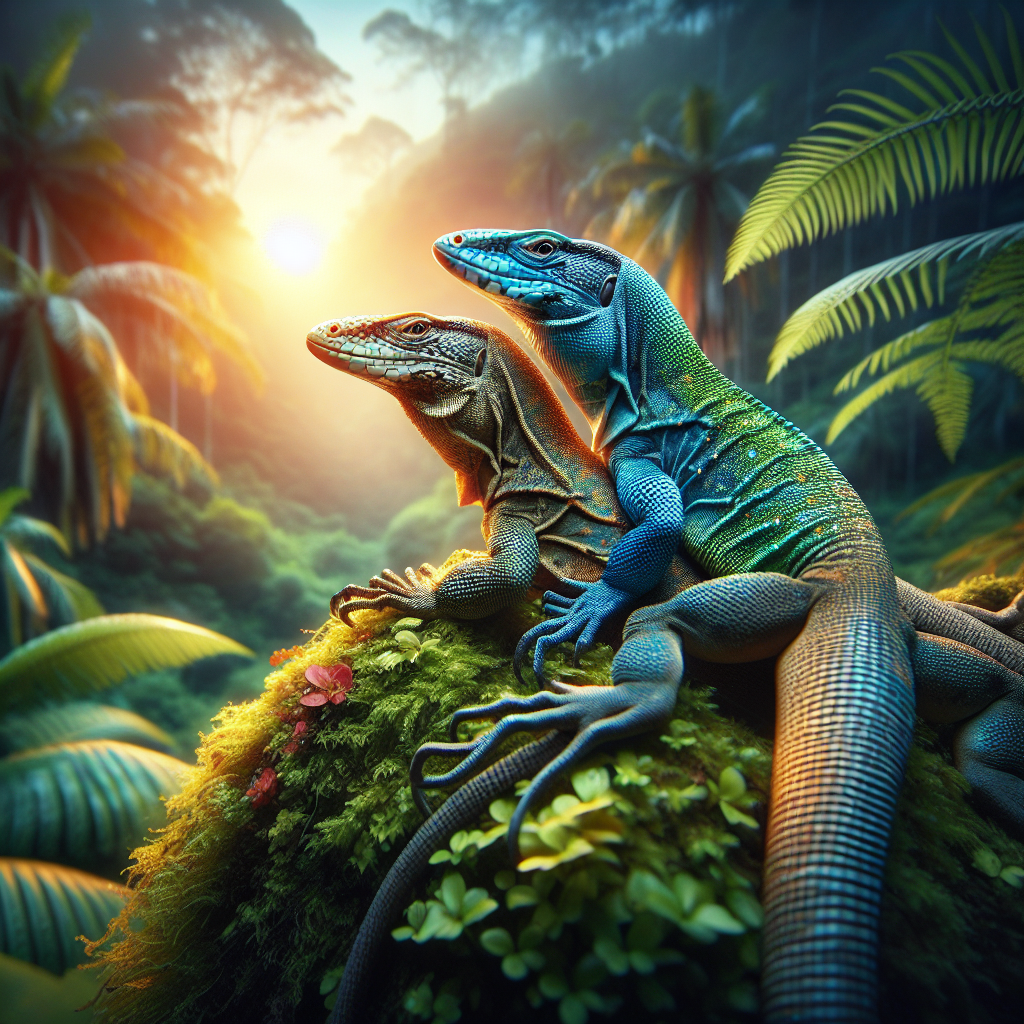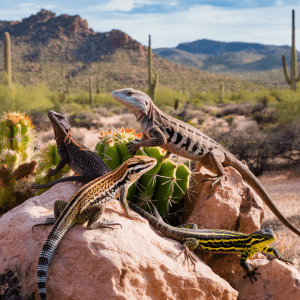Introduction: Understanding Lizard Mating Behavior
Have you ever wondered how lizards find their perfect mate partners in the wild? It’s a fascinating world out there, filled with complex behaviors and intriguing interactions. Picture this: a male lizard strutting his stuff, showing off his vibrant colors or performing elaborate dances to catch the eye of a potential partner. It’s like a scene straight out of a nature documentary!
Lizard mating behavior is not just about finding any partner; it’s about finding the right one. These creatures have their own unique ways of attracting mates, from visual displays to vocalizations that can be quite mesmerizing to observe. Each species of lizard has its own set of rituals and signals to communicate their interest and availability to potential partners.
One interesting fact about lizard courtship is that some species engage in elaborate dances or push-up displays to showcase their strength and vitality. It’s almost like a dance-off in the animal kingdom! These behaviors not only serve to attract mates but also help establish dominance and hierarchy within the lizard community.
Understanding the intricacies of lizard mating behavior can offer valuable insights into the evolutionary processes shaping their reproductive strategies. It raises questions about the role of natural selection in driving mate selection preferences and the impact of environmental factors on these complex behaviors.
As we delve deeper into the world of lizard mate selection, we begin to appreciate the beauty and complexity of nature’s design. It’s a reminder that every creature, no matter how small, plays a crucial role in maintaining the delicate balance of ecosystems. So next time you spot a lizard basking in the sun, take a moment to marvel at the intricate dance of life unfolding right before your eyes.
How Do Lizards Attract Their Partners?
Have you ever wondered how lizards manage to attract their partners in the wild? It’s quite fascinating to observe these little creatures in their natural habitat, engaging in various behaviors to court potential mates. One interesting fact about lizard courtship is that different species employ unique strategies to catch the eye of their desired partners.
For instance, some male lizards showcase their colorful and vibrant markings to signal their fitness and attractiveness to females. It’s like putting on your best outfit for a special occasion! These visual displays play a crucial role in attracting mates and establishing dominance within the lizard community. Imagine strutting your stuff to impress a potential partner – it’s a universal concept, even in the reptilian world!
Additionally, scent communication is another key aspect of lizard courtship. Just like how we may wear a particular perfume or cologne to appeal to others, lizards release pheromones to signal their availability and readiness to mate. These chemical signals help individuals identify suitable partners and navigate the complex social dynamics of the lizard world.
Understanding how lizards attract their partners offers valuable insights into their evolutionary history and ecological adaptations. By studying these behaviors, researchers can unravel the intricate mechanisms behind mate selection and reproductive success in different lizard species. It’s like piecing together a puzzle to uncover the hidden complexities of nature’s design.
So, next time you spot a lizard engaging in a quirky dance or displaying its colorful patterns, take a moment to appreciate the intricate courtship rituals at play. Who knew that the world of lizard romance could be so captivating and full of surprises? Nature truly knows how to put on a show, even in the smallest and most unexpected of creatures.
The Role of Communication in Lizard Courtship
Let me tell you about the fascinating role of communication in lizard courtship. Did you know that lizards use a variety of methods to communicate their intentions during the mating process? It’s like a secret language they’ve developed over time! These little reptiles are quite the chatterboxes when it comes to finding their perfect mate.
Imagine you’re a lizard basking in the sun, trying to catch the eye of a potential partner. You might start by performing elaborate displays, such as head bobbing or push-ups, to show off your strength and agility. It’s like a lizard dance party out there! These movements are not just for show; they play a crucial role in signaling readiness to mate and establishing dominance in the lizard dating scene.
But communication goes beyond just physical displays. Lizards also use vocalizations, such as chirps or hisses, to convey their interest and ward off rivals. It’s like they have their own lizard language, complete with sweet serenades and fierce warnings. These vocal cues help lizards navigate the complex social dynamics of courtship and ensure they find the right partner to carry on their genes.
This intricate communication system is essential for successful mate selection in lizards. It allows them to assess each other’s fitness, compatibility, and reproductive status before committing to a partnership. Just like humans use words to express their feelings and intentions, lizards rely on a range of signals to navigate the tricky world of courtship.
So, the next time you spot a lizard in the wild, take a moment to appreciate the subtle ways they communicate with each other during courtship. It’s a reminder that love languages exist not just in the human world but also in the fascinating realm of lizard romance.
Factors Influencing Mate Selection in Lizards
Have you ever thought about the factors that influence mate selection in lizards? It’s pretty fascinating stuff! Just the other day, I was reading about how different traits can play a role in determining which lizard becomes a preferred partner. For instance, the size and coloration of a lizard can be crucial in attracting a mate. It’s like a lizard beauty pageant out there in the wild!
One interesting fact I came across is that some lizards engage in complex courtship rituals to impress potential partners. These rituals can involve intricate displays of behavior, such as head-bobbing, tail-waving, or vocalizations. It’s like watching a lizard dance party unfold in the desert!
Now, when it comes to mate selection, it’s not just about looks. Lizards also consider other factors like territory, resources, and even genetic compatibility. It’s a bit like lizards are playing their version of a dating game show, where they have to weigh different options before making their final choice.
But here’s the kicker – sometimes there can be controversies surrounding mate selection in lizards. Some researchers debate whether lizards prioritize certain traits over others when choosing a mate. It’s like a scientific soap opera, with different theories and hypotheses clashing in the research world.
So, next time you see a lizard basking in the sun, take a moment to appreciate the complexity of their mating behavior. Who knew that these seemingly simple creatures have such intricate ways of finding their perfect partner? It’s like a miniature world of love and drama playing out in the lizard kingdom!
Unique Mating Rituals of Different Lizard Species
Have you ever wondered about the unique mating rituals of different lizard species? It’s truly fascinating to explore how these creatures attract their partners in the wild. One interesting fact that I came across during my research is that some lizard species engage in elaborate displays of color and movement to court their potential mates. It’s almost like a dance performance in the animal kingdom!
I remember watching a nature documentary where they showcased the courtship ritual of the male frilled lizard. It was both amusing and impressive to see how the male lizard expanded its frill to display vibrant colors and intimidate rivals while trying to impress the female. The lengths that some lizards go to in order to attract a mate are truly remarkable!
One practical tip when observing lizard mating behavior is to maintain a safe distance and avoid disturbing them in their natural habitat. It’s important to remember that these behaviors are essential for their survival and reproductive success. By observing from a distance, we can appreciate the beauty of nature without interfering with the delicate balance of ecosystems.
Thinking about the broader implications of lizard mating rituals, it’s fascinating to consider how environmental factors and human activities can impact their ability to find mates. Conservation efforts play a crucial role in preserving the habitats where these unique behaviors occur. Understanding and respecting the mating behaviors of lizards can help us appreciate the biodiversity of our planet and the interconnectedness of all living organisms.
So, next time you spot a lizard in the wild, take a moment to observe its behavior and appreciate the intricate dance of nature unfolding right before your eyes. Who knows, you might witness a courtship ritual that will leave you in awe of the wonders of the animal kingdom!
Environmental Impact on Lizard Mating Patterns
Have you ever considered how the environment plays a crucial role in influencing the mating patterns of lizards? It’s fascinating to see how factors such as temperature, habitat type, and resource availability can impact their reproductive behaviors. Let me share an interesting fact with you – did you know that some lizard species adjust their mating rituals based on the environmental conditions they are in? It’s like they have a built-in adaptive mechanism that allows them to thrive in diverse habitats.
Imagine observing a group of lizards in the wild, each species showcasing unique mating rituals tailored to their surroundings. For instance, desert-dwelling lizards may have evolved strategies to cope with extreme heat and limited water resources, affecting how they attract mates and reproduce. On the other hand, forest-dwelling species might rely on different cues and behaviors to navigate their lush environment and find suitable partners.
This environmental impact on lizard mating patterns raises thought-provoking questions about the resilience and adaptability of these fascinating creatures. How do lizards adapt to changing environmental conditions over time, and what implications does this have for their long-term survival? It’s like a puzzle waiting to be solved, with each new discovery shedding light on the intricate relationship between lizards and their habitats.
Exploring the challenges and opportunities presented by environmental factors in lizard mating studies opens up a world of possibilities for researchers and conservationists. By understanding how lizards respond to their changing surroundings, we can gain valuable insights into biodiversity conservation and ecosystem management. So next time you observe a lizard engaging in its elaborate courtship dance, remember that its behavior is not just a random display – it’s a carefully crafted response to the world it inhabits.
Reproductive Success and Survival Strategies
Imagine we’re sitting down over a cup of coffee, and I’m telling you about the fascinating world of lizard mating behaviors. Let’s dive into the topic of reproductive success and survival strategies in these scaly creatures.
So, here’s the deal – when it comes to lizards and their quest for mating success, it’s not just about finding a partner; it’s about ensuring the survival of their offspring. Lizards have evolved some pretty clever strategies to increase their reproductive success and give their babies the best chance at thriving in the wild.
Picture this: a female lizard carefully selecting a mate based on his genetic quality and fitness. It’s like a real-life version of a dating show, but with a scientific twist. By choosing a genetically strong partner, the female increases the likelihood of producing healthy offspring with a better chance of survival.
Now, here’s where it gets really interesting. Some lizard species have developed intricate behaviors to protect their eggs and young from predators. From burying their eggs in hidden nests to fiercely defending their territory, these lizards are not messing around when it comes to ensuring the survival of their offspring.
But it’s not all smooth sailing in the world of lizard reproduction. Challenges like habitat loss, climate change, and human interference pose serious threats to the survival of many lizard species. As their natural habitats shrink and populations decline, lizards are facing an uphill battle to maintain their reproductive success and ensure the survival of future generations.
So, next time you spot a lizard basking in the sun or darting across the desert sands, take a moment to appreciate the incredible strategies these creatures have developed to navigate the complex world of reproduction and survival. Who knew that behind those tiny scales lies a world of evolutionary marvels and survival tactics?
Human Intervention and Conservation Efforts
When it comes to human intervention in lizard mating patterns and conservation efforts, it’s like being caught between a rock and a hard place. You see, on one hand, we understand the importance of preserving these unique creatures and their natural habitats. But on the other hand, our actions can inadvertently disrupt their delicate mating rituals and impact their reproductive success.
Picture this: a team of well-meaning researchers sets out to study a population of lizards in a remote area. They want to gather data to aid in conservation efforts and protect these fascinating creatures. However, their presence and activities may unknowingly disturb the lizards’ natural behaviors, potentially affecting their ability to find mates and reproduce.
It’s a tricky situation, isn’t it? We want to help, but sometimes our efforts can have unintended consequences. This dilemma raises an important question: How can we strike a balance between conservation and interference when it comes to lizard mating patterns?
One interesting fact to consider is that some researchers have found creative solutions to minimize human impact on lizard mating behaviors. For example, using remote cameras and non-invasive monitoring techniques allows scientists to observe lizards without disturbing them. By taking a hands-off approach, researchers can gather valuable data while minimizing interference with the lizards’ natural mating processes.
So, the next time you hear about conservation efforts involving lizard populations, remember the delicate dance between intervention and preservation. It’s a complex issue that requires careful consideration and a thoughtful approach. After all, we want these fascinating creatures to thrive and continue their unique mating rituals for generations to come.
Future Research Directions in Lizard Mating Studies
Imagine this – have you ever thought about how studying lizard mating behavior could help us understand our own relationships better? It’s fascinating how research in this area can provide insights into mate selection strategies, communication dynamics, and reproductive success not just in lizards, but potentially in humans too.
As we delve into future research directions in lizard mating studies, it’s like peering into a window of possibilities. The discoveries made in this field could have far-reaching implications beyond the reptilian realm. Just think about it – could the way lizards choose their partners inform us about our own patterns of attraction and mate selection?
The idea that understanding lizard mating behaviors might shed light on human relationships may seem far-fetched at first, but consider this: both humans and lizards are driven by innate biological instincts when it comes to finding a suitable mate. By exploring the factors that influence mate selection in lizards, scientists may uncover universal principles that apply across species boundaries.
So, as we ponder the future of lizard mating studies, it’s not just about observing these fascinating creatures in their natural habitats. It’s about recognizing the interconnectedness of life on Earth and the shared evolutionary strategies that have shaped diverse mating behaviors. Who would have thought that studying lizards could lead us to reflect on our own romantic pursuits and societal norms?
In a way, the study of lizard mate selection serves as a mirror that reflects back to us our own quest for connection and companionship. So, the next time you see a lizard basking in the sun or engaging in a courtship dance, remember that there may be more to their behavior than meets the eye. Perhaps, in understanding lizards, we can also gain a deeper understanding of ourselves.
Conclusion: Appreciating the Complexity of Lizard Mate Selection
Have you ever wondered about the fascinating world of lizard mating behavior? It’s truly a captivating topic that showcases the diverse and intricate ways in which these creatures find their partners. Let me take you on a journey through the intriguing realm of lizard courtship.
Picture this – you’re walking through a lush forest, and suddenly you spot two lizards engaging in a mesmerizing dance. This personal anecdote highlights the beauty of witnessing these intricate mating rituals firsthand. Lizards have developed various strategies to attract their partners, from colorful displays to intricate movements that showcase their prowess and attractiveness.
Did you know that some lizard species use pheromones to communicate during courtship? This interesting fact sheds light on the chemical signals that play a crucial role in their mating rituals. Understanding these unique communication methods can give us a deeper insight into the complex world of lizard relationships.
While lizard courtship may seem like a harmonious dance, there are challenges and controversies surrounding mate selection in the lizard kingdom. Factors such as competition, territorial disputes, and environmental changes can influence their mating patterns, leading to intriguing dynamics that are worth exploring.
If you ever find yourself observing lizards in their natural habitat, here’s a practical tip – maintain a respectful distance to avoid disrupting their courtship rituals. By giving them space, you can observe their behaviors without interfering with their natural instincts.
Now, here’s a thought-provoking question for you – how do environmental changes impact lizard mating behaviors? This prompts us to consider the broader implications of habitat loss, climate change, and human intervention on the delicate balance of lizard courtship rituals.
As we delve into the world of lizard mate selection, it becomes clear that these creatures have evolved fascinating strategies to find their partners. From colorful displays to intricate dances, lizard courtship offers a glimpse into the mesmerizing complexities of nature’s matchmaking.



